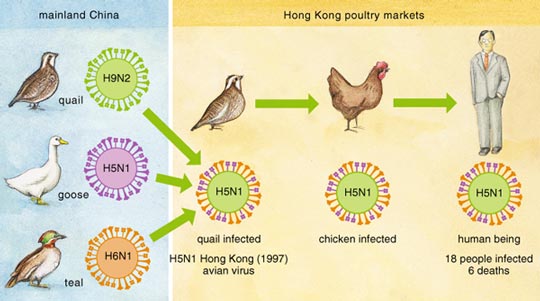|
|
|
|
Genetic
Shift in Influenza Viruses
 |
|
|
The world is teetering on the edge of a pandemic of Influenza. The 2009 H1N1 virus was originally referred to as “swine flu” because laboratory testing showed that many of the genes in this new virus were very similar to influenza viruses that normally occur in pigs in North America. But further study has shown that this new virus is very different from what normally circulates in North American pigs. It has two genes from flu viruses that normally circulate in pigs in Europe and Asia and avian genes and human genes. U.S. map. Hong Kong’s deadly H5N1 (1997) virus is believed to be a product of three viral strains found respectively in quail, geese and teal from mainland China. The birds are housed together in Hong Kong’s poultry markets, which provides an optimal environment for genetic reassortment. Surveillance studies in the poultry markets have shown that quail are susceptible to all tested strains of influenza viruses, and that they can serve as an intermediate host between ducks and chickens. Quail may have been very important in the genesis of the 1997 H5N1 influenza virus, which killed six people. To reduce the probability that other H5N1 flu viruses will emerge, quail are now banned from the live chicken markets in Hong Kong. The H5N1 virus re-emerged in Hong Kong’s poultry markets in 2001, necessitating the slaughter of all poultry for the second time in four years. Poultry markets appear to play an important role in the emergence of reassortant influenza viruses. Influenza H5N1 re-emerged in 2004 with several human cases in Vietnam, deaths were reported, and two cases in Thailand. |
|
|
CDC. "Novel Influenza A (H1N1) virus infections."
MMWR. May 8, 2009 / 58(17);453-458 |
|
Back to top |